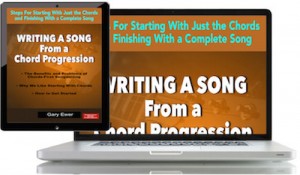If you’ve ever written an instrumental, you’ve hopefully noticed that the same principles of good composition apply as when writing a song that’s meant to be sung. The way the chords work, the way you shape the melodies, and the general ideas behind production issues — these things stay the same whether you’re writing a song with or without vocals.
One of the biggest problems that developing songwriters face when writing an instrumental is coming up with an engaging melody. It’s often easier to think of melody if you have words and phrases attached to the notes than if you’re simply trying to come up with a sequence of notes.
But that’s got me thinking: is it ever possible to write an instrumental where it’s main interest is the chord progression? Examples are rare, but there are a few, and it’s worth looking at them to try to understand how they can be successful.
 “Writing a Song From a Chord Progression” is an eBook that shows you the best way to develop a songwriting process that starts with chords. It’s part of “The Essential Secrets of Songwriting” 10-eBook Deluxe Bundle. Get today’s special deal.
“Writing a Song From a Chord Progression” is an eBook that shows you the best way to develop a songwriting process that starts with chords. It’s part of “The Essential Secrets of Songwriting” 10-eBook Deluxe Bundle. Get today’s special deal.
Back in 1973, Genesis recorded “Firth of Fifth“, credited to the full group, but written mainly by keyboardist Tony Banks. The opening piano solo, lasting just over a minute, is a good example of an instrumental based on chords, with only the merest notion of a melody:
When I was an instructor at Dalhousie University, I required my ear training students to transcribe that opening solo. It’s a fantastic piece of music, and it’s interesting how one only gets the slightest hint of melody. It’s the chords and the complex rhythms and time signatures that give the excerpt the requisite energy and momentum.
There’s a similar kind of piece in the classical music world: “Toccata”, from Charles-Marie Widor’s famous “Symphony for Organ No. 5”. Listen to this, and you’ll notice the same kind of emphasis on chords and rhythm, with almost nothing that can be picked up right away as being a melody:
If you’ve got a good sound system, turn it up and listen right to the end. This performance by Frederick Hohman is amazing.
Comparing “Firth” and “Toccata”, you can learn a lot about how to write instrumental music when the emphasis is not on the melody. Here are some points to ponder:
- The melody isn’t completely missing. The more you listen to these two great works, the more you notice that while the melody doesn’t sit prominently in the foreground waving a flag, you start to become aware of shapes that come from the contours created by the tops of the chords, that come across as a kind of melody.
- In the absence of strong melody, there needs to be more emphasis on rhythm, time signatures and clever use of instrumentation. You notice in “Firth” that syncopation and complex time signatures grab our interest right away. In Widor’s “Toccata”, it’s the relentless pumping action of the repetitive rhythm that gets used to present the chords. In any case, something needs to step up and grab attention if a melody isn’t going to do it.
- Complex chords need moments of strength in the absence of a strong melody. In “Firth”, the music starts in Bb major, then travels through Eb major, then to Gb major, before finally moving back to the original key of Bb major. There is a moment of musical uncertainty for each change of key, but once the new key is established, the chords we’re given are strong and obviously rooted in the new key. That gives a strong sense of structure that’s necessary for this kind of music.
- Follow no-melody sections with ones that feature strong melody. If you choose to write a song where the melody is not so noticeable, remember that you can (maybe even should) follow it with a section that features a stronger melody, and that kind of contrast works beautifully, especially in longer songs. Listen to the section in “Firth” that follows the piano introduction, at about the 1’10” mark, and you’ll hear many other sections that put a strong melody front and centre.
- The same principles apply whether a song is sung or not. Even without a noticeable melody, you should see that production issues, chords, instrumentation, rhythm, and other elements, all operate the same way as they do in songs that are sung.
Songs that use chords as one of the most important aspects of composition won’t succeed if it’s only chords that are trying to draw attention. Remember to do something interesting in the rhythmic treatment of those chords, and hopefully it goes without saying that an instrumental needs to do something interesting with the main instrument.
 Written by Gary Ewer. Follow Gary on Twitter.
Written by Gary Ewer. Follow Gary on Twitter.
 If you’re looking for one set of eBooks that will cover everything you need to know about writing songs –creating melodies, lyrics, chord progressions, and more — “The Essential Secrets of Songwriting” 10-eBook Deluxe Bundle is what you’re looking for. It always comes with a SPECIAL DEAL.
If you’re looking for one set of eBooks that will cover everything you need to know about writing songs –creating melodies, lyrics, chord progressions, and more — “The Essential Secrets of Songwriting” 10-eBook Deluxe Bundle is what you’re looking for. It always comes with a SPECIAL DEAL.











Pingback: Songs With Almost No Melody - The Hit Songwriting Formula | The Hit Songwriting Formula